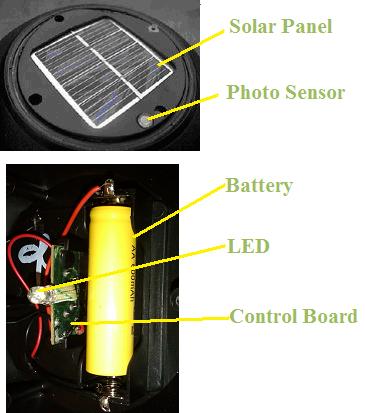
Article - How Do Solar Lights Work?
Solar lights will work in most areas; however solar lights will work well only as long as the solar panel receives at least 6 – 8 hours of sunlight a day. If solar lights are placed in an area that receive less sunlight than the solar panel needs to fully charge the battery, the light will operate for fewer hours per night than expected. Shading of the solar panels during the day by landscape features, such as vegetation, buildings, etc will also affect battery charging and performance. Solar lights also perform better if they are placed in an area that is dark at night, if the sensor does not detect darkness at night the solar light will not come on.
Solar Light Components:
-
- The Case
- Solar Panel
- Controller Board
- LED Light
- Rechargeable batteries
- Photo Sensor
- Diode

A single solar panel produces a maximum of 0.45 volts and a varying amount of current depending on the size of the panel and the amount of sun light the solar panel receives. In a typical solar yard light there is four solar cells attached together, and will produce around 1.8 volts and a maximum of about 100 milliamps in full sunlight.
The solar panel is wired directly to the battery through a diode (which prevents the battery's current from flowing back through the solar cell at night). The battery is a completely standard NiCad rechargeable battery. These batteries produce about 1.2 volts and can store a maximum of approximately 900 milliamp-hours. During the day, the battery charges, reaching maximum charge except on shorter winter days or days when there is heavy overcast. At night, the solar cells stop producing power. The photo sensor automatically turns on the LED light at night when it detects darkness.
The controller board accepts power from the solar panel and battery, as well as input from the photo sensor. It has a three-transistor circuit that turns on the LED when the photo sensor indicates darkness. The LED draws about 45 milliamps with the battery producing about 1.23 volts (0.055 watts). The NiCad battery, when fully charged, can operate the LED for about 8-12 hours.
Almost all-solar lights use LED's as their light source. An LED is a light emitting diode. It is not really a light bulb but an electrical component that emits light. These electrical components proven highly reliable, giving off almost no heat and have a life expectancy of up to 20 years.
Posted by Donna Clinton